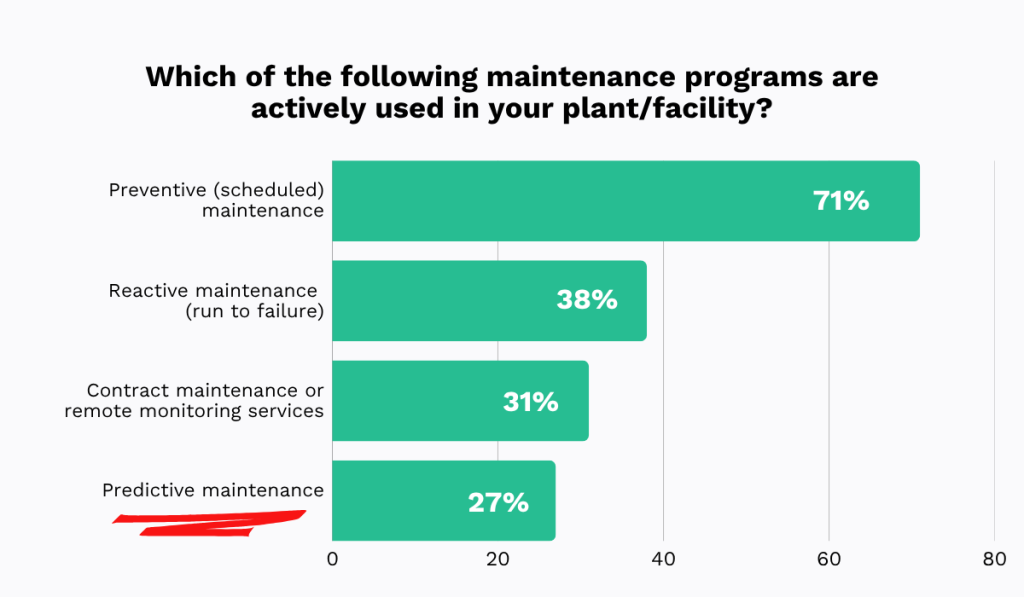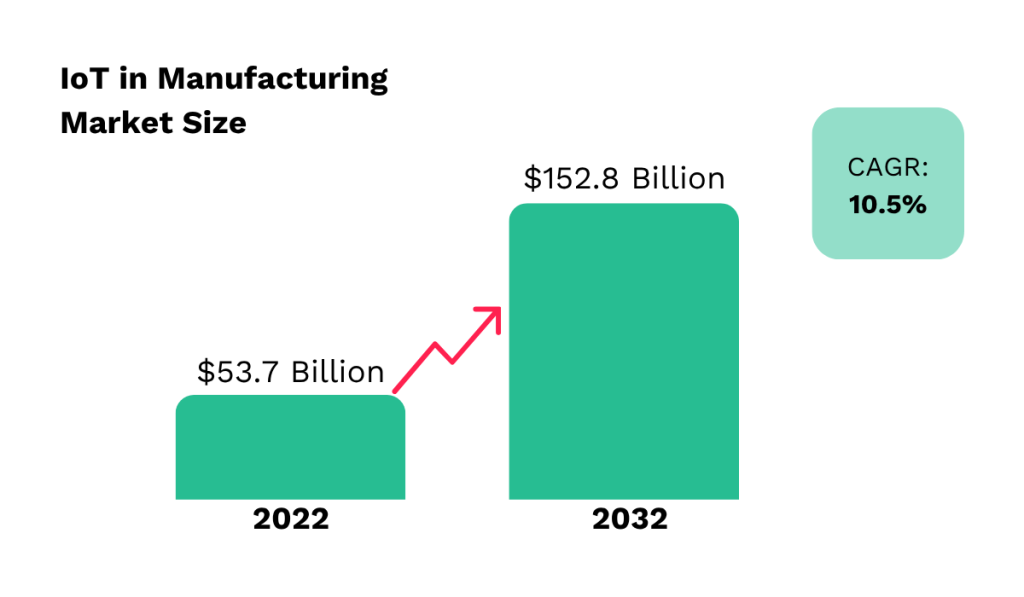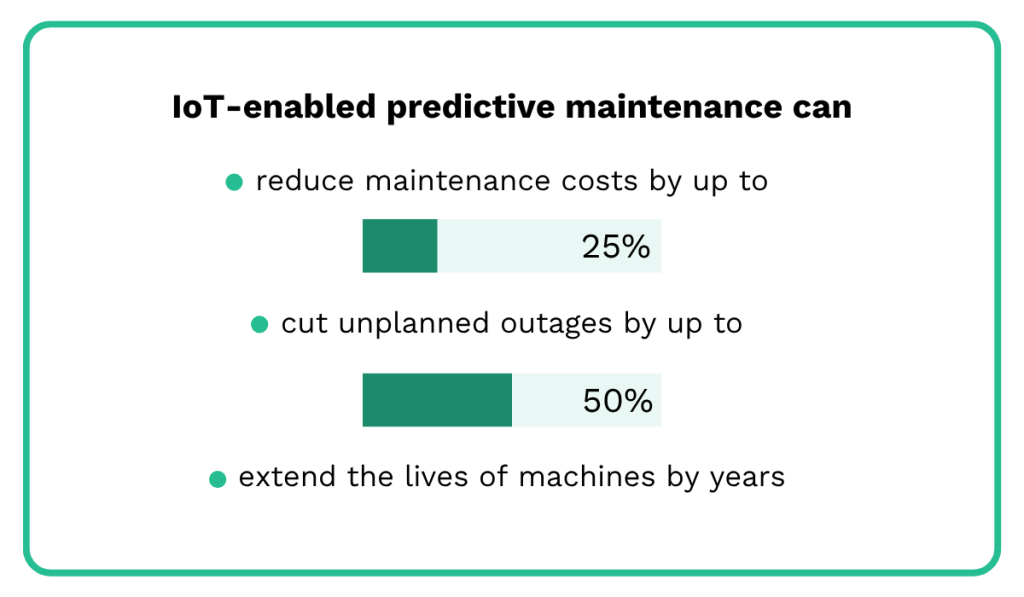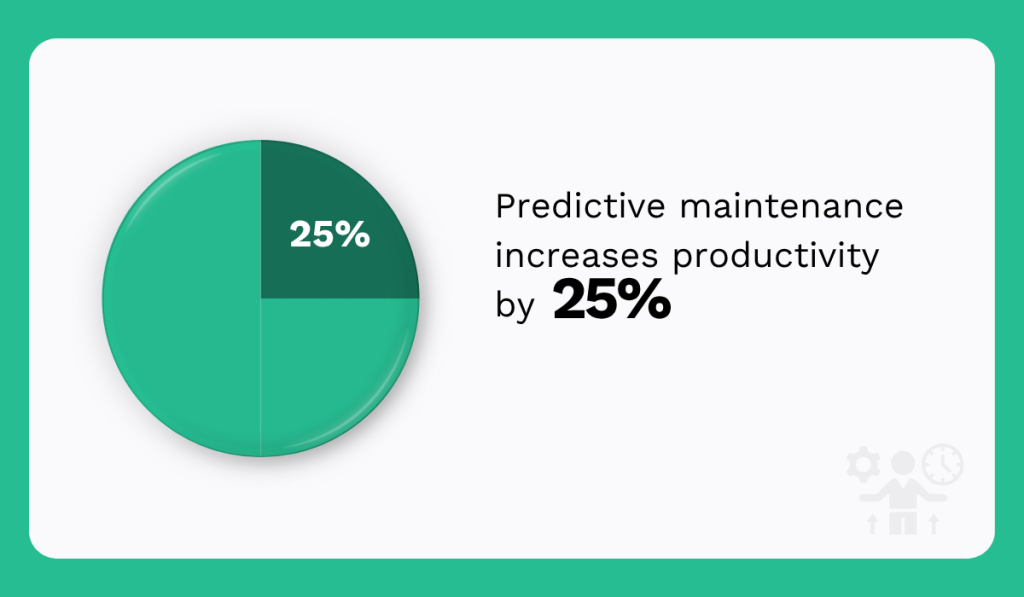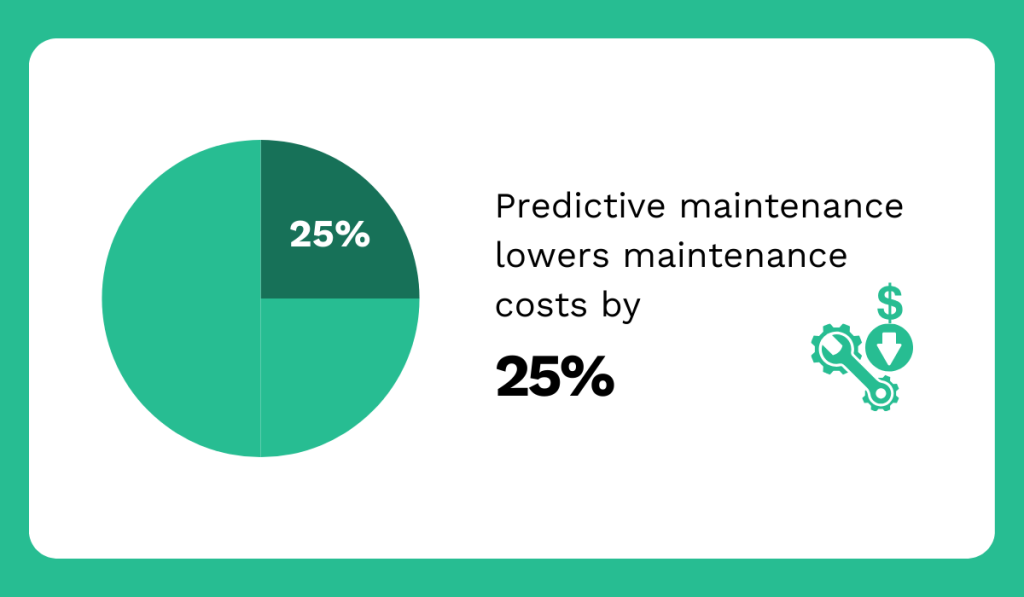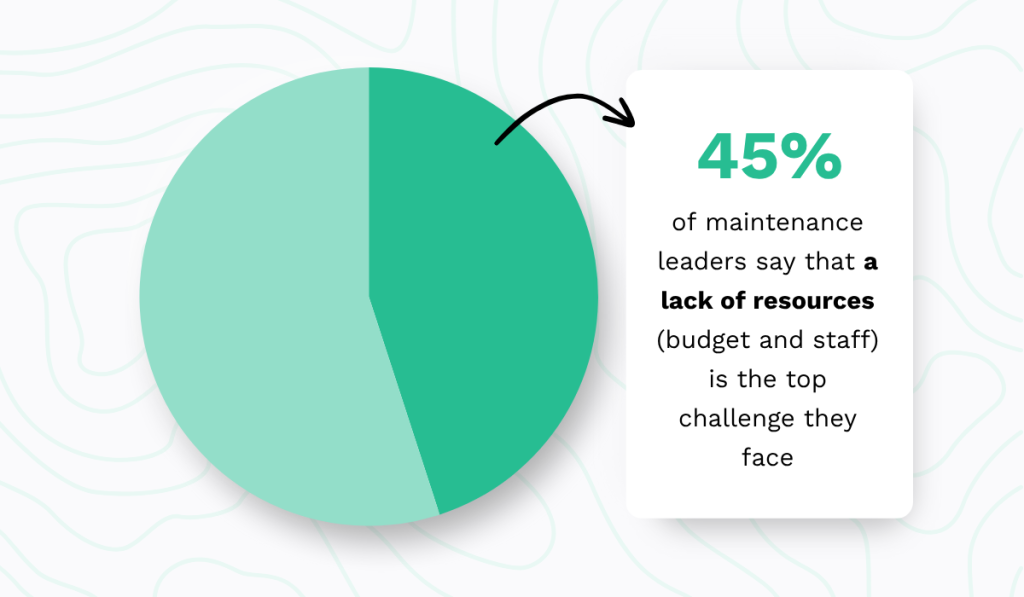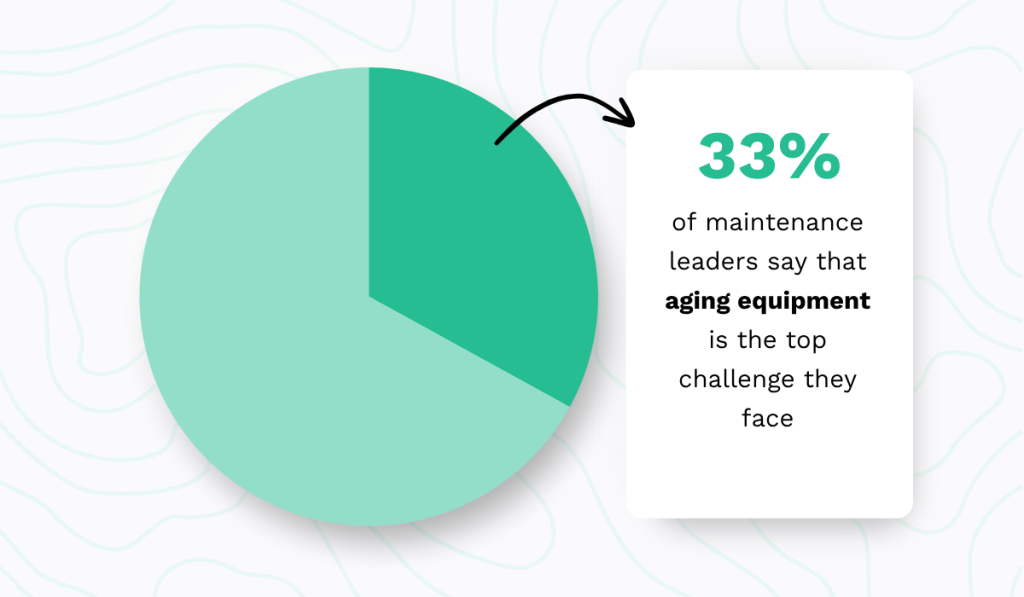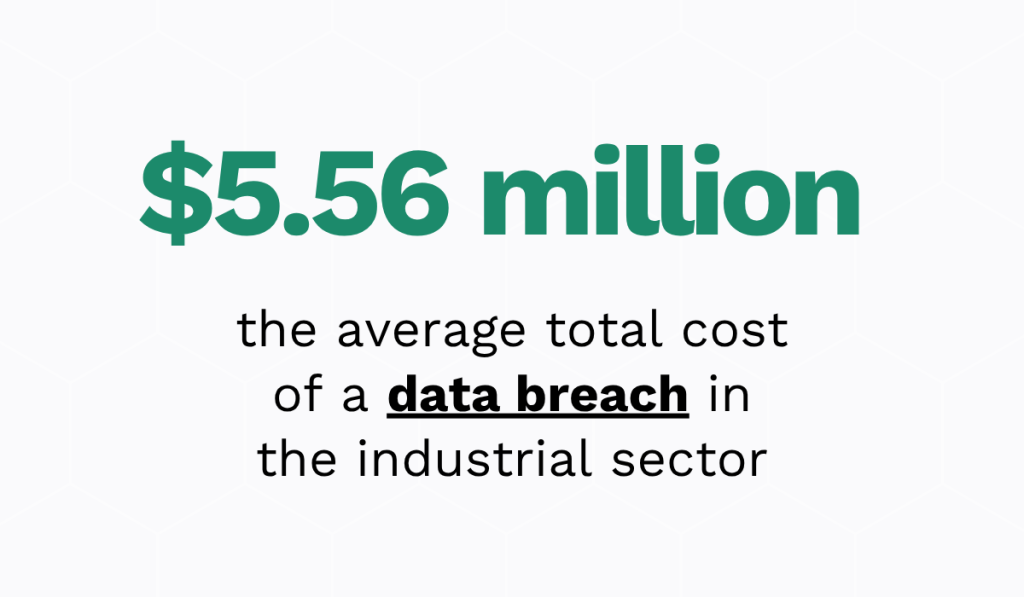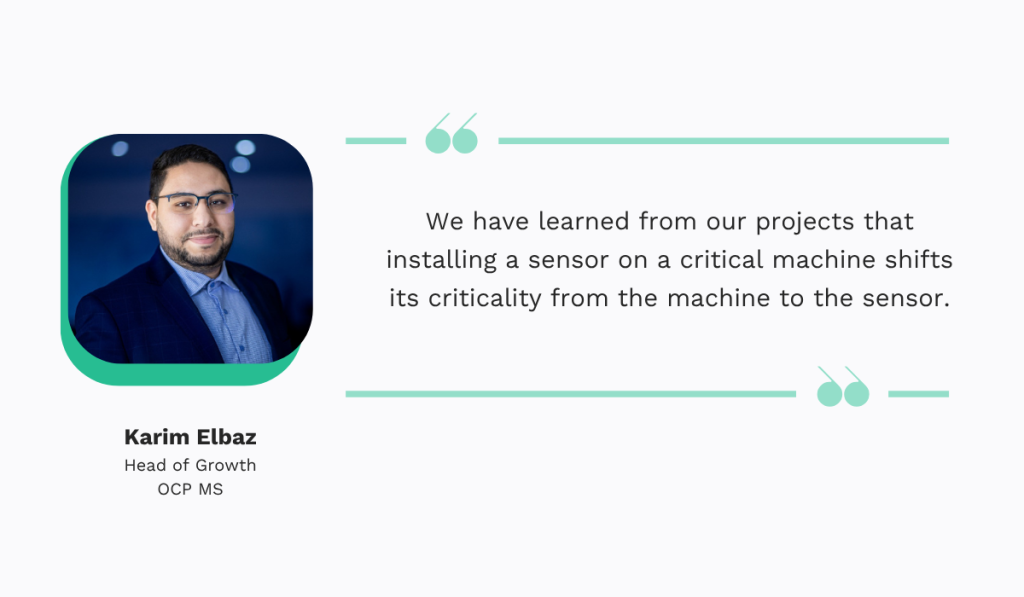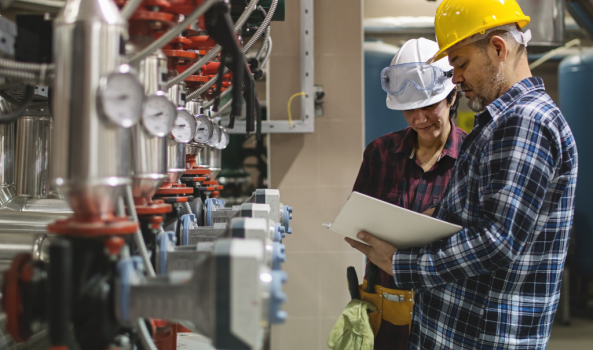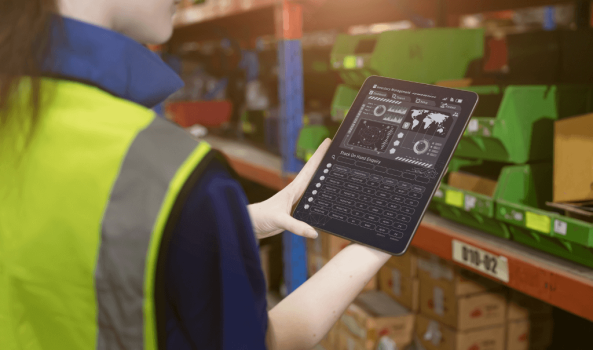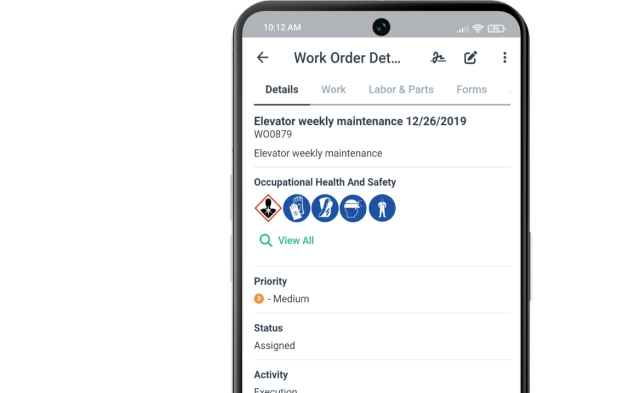Get a Free WorkTrek Demo
Let's show you how WorkTrek can help you optimize your maintenance operation.
Try for freeKey Takeaways:
- IoT sensors enable real-time monitoring, making early failure detection and proactive maintenance possible.
- Common IoT sensors used in predictive maintenance include vibration, temperature, pressure, and oil quality sensors.
- 49 targeted cyberattacks per week hit the average manufacturing organization’s IoT devices.
Unplanned downtime can cost millions in modern manufacturing.
Maintenance strategies have, therefore, evolved from reactive fixes to smarter, data-driven approaches.
One of the most effective among these is predictive maintenance (PdM), and at its core lies the Internet of Things (IoT).
Together, they are transforming how manufacturers maintain equipment, plan interventions, and ensure operational continuity.
Read on to learn what role IoT plays in all of this.
What is Predictive Maintenance?
Predictive maintenance (PdM) is a proactive maintenance strategy.
Its purpose is to forecast equipment failures by analyzing data gathered from machines and their operating environments.
Unlike reactive maintenance, which addresses issues after they happen, or preventive maintenance, which schedules interventions regardless of actual wear, PdM relies on real-time condition monitoring.
In other words, it ensures that maintenance is carried out only when necessary, based on the actual health of the machine.
Today, predictive maintenance ranks as the fourth most widely used maintenance approach, following preventive and reactive methods.
The continued dominance of traditional approaches is often attributed to their simplicity, familiarity, and lower upfront implementation costs.
However, these are increasingly being questioned as manufacturers seek greater efficiency, reliability, and cost control.
That’s precisely what PdM delivers.
Kevin Tucker, Advisory Practice Lead at Info-Tech Research Group, notes:
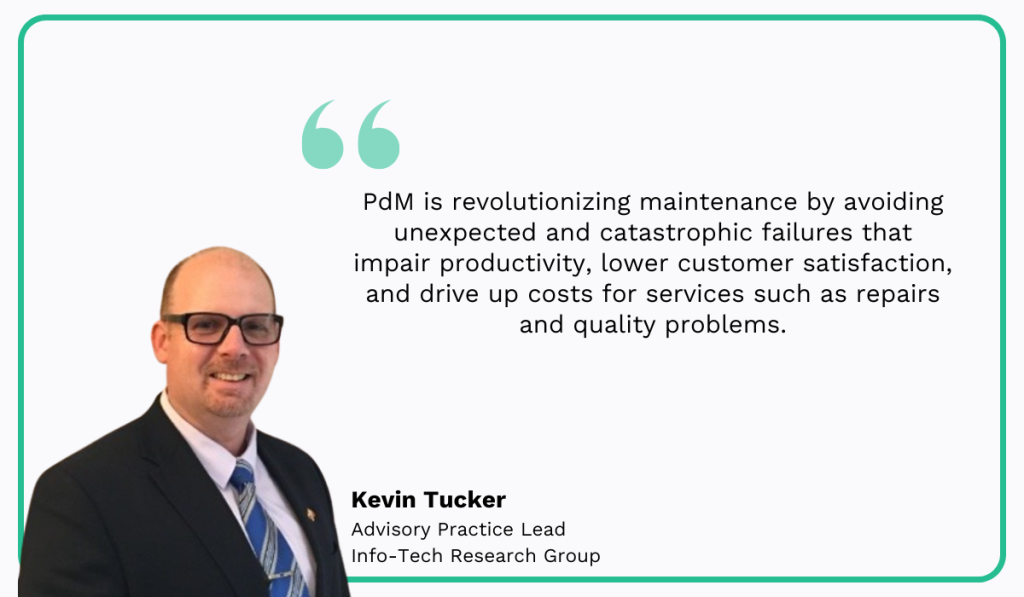
Implementing predictive maintenance effectively depends heavily on high-quality, timely data.
And IoT plays a key role here.
How IoT Enables Predictive Maintenance
The Internet of Things (IoT) refers to the network of interconnected devices embedded with sensors, software, and connectivity, enabling them to collect and exchange data.
In manufacturing, IoT technology equips machinery with intelligent sensors that continuously monitor various operational and environmental parameters, including:
- Vibration
- Temperature
- Humidity
- Pressure
- Energy consumption
This constant data flow creates a real-time overview of asset health.
IoT in the manufacturing sector is expanding rapidly.
In 2022, the market was valued at $53.7 billion and is projected to reach $152.8 billion by 2032, growing at a CAGR of 10.5%.
This growth reflects the growing reliance on connected systems to drive smarter maintenance practices.
A wide range of sensors supports IoT-driven PdM, including temperature, humidity, gas, and pressure sensors.

Some advanced types—such as nanotechnology-powered sticker sensors—offer flexible, low-power options for environments with restricted space or exposure to harsh conditions.
The data these sensors collect is transmitted either wirelessly or via wired connections to centralized platforms.

In some cases, data is processed locally using edge computing —a technology that enables data analysis close to the source, rather than relying on remote cloud servers.
Edge computing reduces latency and enhances reliability, which is especially important in time-sensitive industrial applications.
Once collected, the sensor data is processed using artificial intelligence (AI) and machine learning (ML) algorithms.
They identify patterns, recognize early warning signs of failure, and recommend timely interventions.
Rakesh Prasad, Senior Vice President of Digital Business at Innover, summarizes the process:
“For PdM, IoT sensors are fitted in machines and equipment to monitor their health and surroundings, gathering data on factors such as vibration, temperature, and humidity.
This data is then relayed to a central system that employs AI/ML algorithms to examine the data and give insights into the equipment or machinery’s well-being.”
The practical advantages of this approach are significant.
McKinsey reported as early as 2015 that the adoption of IoT technologies in maintenance could reduce costs by up to 25%, cut unplanned outages by 50%, and extend the lifespan of machines by several years.
As manufacturers navigate tight margins and high production demands, these efficiencies yield substantial benefits.
Benefits of IoT-Based Predictive Maintenance
The most immediate benefit of IoT-based predictive maintenance is the ability to detect failures before they occur.
By monitoring subtle anomalies, such as vibration patterns, heat fluctuations, or shifts in energy usage, manufacturers can identify and address mechanical issues early, thereby avoiding costly breakdowns.
This reduces unplanned downtime, keeping production running smoothly.
According to a Deloitte report, predictive maintenance can increase productivity by an average of 25%.
However, the true value becomes clear when examining how manufacturers apply these technologies in practice.
One global manufacturer partnered with Techseria, a Microsoft Solution Partner for Data & AI, to implement predictive maintenance across its production facilities.
IoT sensors were installed throughout the plant, feeding real-time data into Azure IoT Hub.
This information was processed using custom machine learning models trained to detect behavioral anomalies in equipment.

The result?
Early warnings are delivered weeks in advance through Power BI dashboards tailored to maintenance priorities.
Naturally, the transformation was measurable.
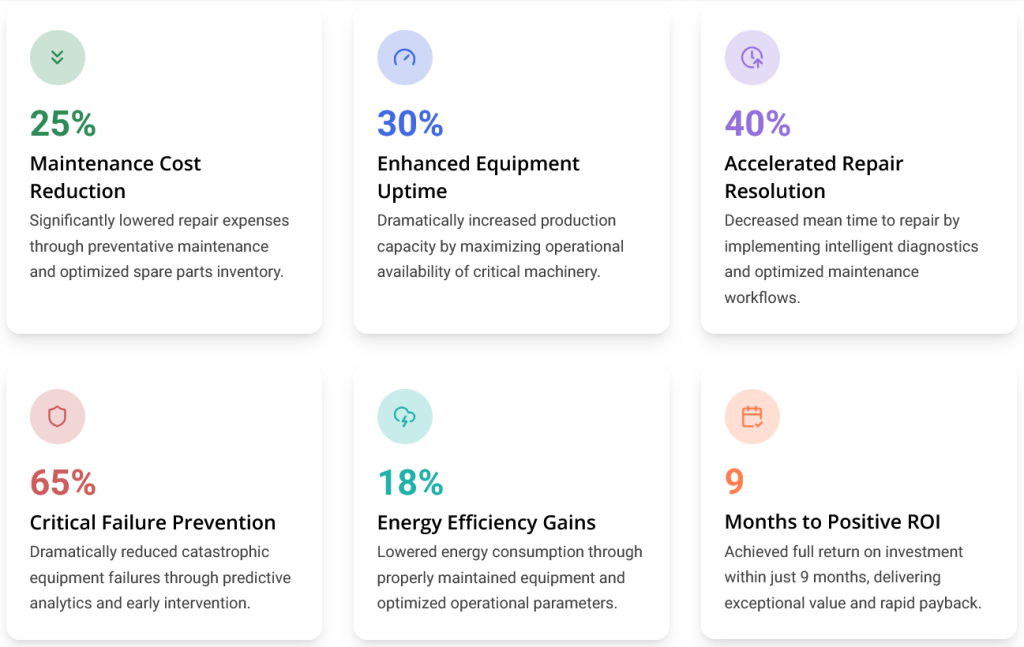
As you can see above, maintenance costs have been reduced by 25%, equipment uptime has improved by 30%, and repair resolution has been accelerated by 40%.
Most importantly, the system prevented 65% of critical failures and delivered an 18% improvement in energy efficiency.
As the Director of Operations reflected:
“The financial impact has been significant—not just the 25% cost reduction, but the additional production capacity from improved uptime. Most importantly, our teams now have the data they need to make smart decisions rather than educated guesses.”
Beyond cost savings, predictive maintenance helps eliminate unnecessary servicing.
Traditional methods often rely on fixed schedules or reactive repair, both of which can result in excessive downtime or wasted resources.
IoT-based PdM changes this by aligning interventions with actual equipment condition, reducing wear-and-tear from over-maintenance, and preventing high-impact failures.
According to the same report by Deloitte, this can reduce maintenance expenses by as much as 25%.
The financial argument strengthens further when considering the cost of unplanned downtime.
In the automotive sector, for instance, one hour of lost production can result in over $2.3 million in losses.
The ability to avoid even a few such interruptions each year has a substantial effect on profitability.
The story of magnetic components manufacturer TCT underscores the broader operational value of IoT-based PdM.
Working with Integral System and Advantech, TCT deployed a comprehensive solution across compressors and motors.
Redwan Kara, IoT Manager at Integral System, describes the sensor technology at the heart of the system:
“The sensor measures raw data along three axes. Inside the sensor, there’s a chip with a controller that applies a Fourier transform to this data in real time. As a result, the sensor provides eight processed indicators per axis. What we send to the software isn’t the raw vibration data, but the processed data after the Fourier transform.”
An AI engine, pre-trained on ISO standard 10816, then analyzed this data, delivering both a machine health score and a predictive forecast for the next seven days.
The infrastructure included the WISE-2410 LoRaWAN® Smart Vibration Sensor and the WISE-6610 V2 Gateway, which ensured secure, long-range communication across the plant.
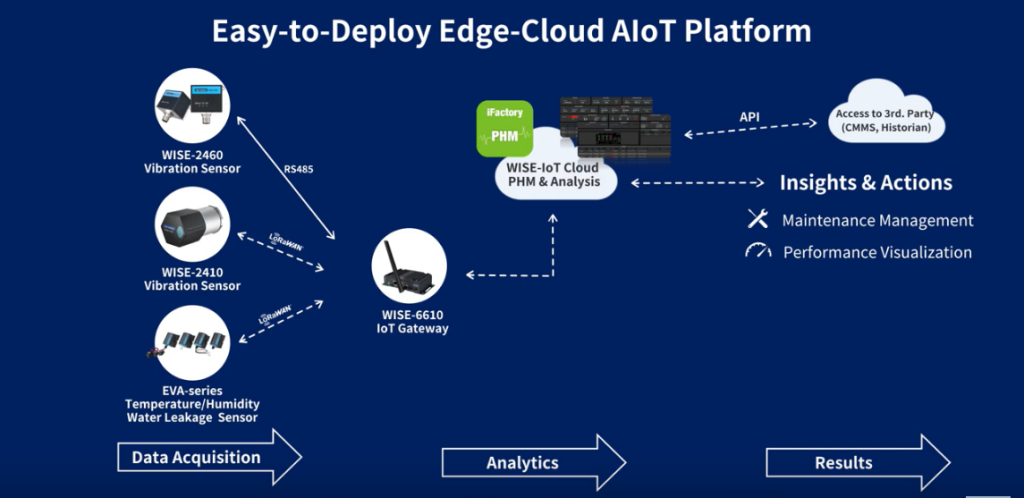
Additional sensors measured current consumption, allowing the system to estimate power usage and operation time.
When the team discovered that the compressor operated at varying speeds, they worked with Advantech’s R&D group to refine the AI algorithm.
This collaboration improved the system’s adaptability to a range of rotating equipment, making predictive alerts even more reliable.
Today, TCT benefits from 24/7 remote monitoring of its compressors, pumps, and motors.
Through Advantech’s IoTSuite dashboards, the team can oversee performance from any location, track key metrics, and receive alerts for abnormalities up to seven days in advance.
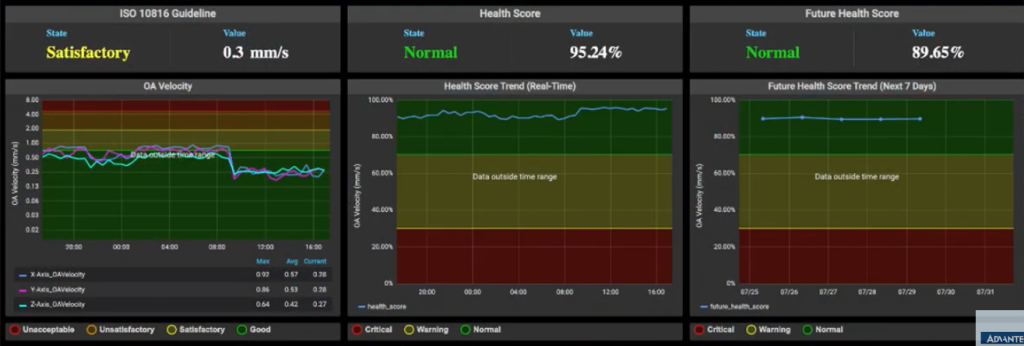
These real-world examples illustrate how IoT-based predictive maintenance delivers more than just technical improvements.
It provides maintenance teams with foresight, enables data-driven planning, and helps safeguard production against costly surprises.
For manufacturers under pressure to optimize costs and output simultaneously, this should be the norm.
Challenges of IoT-Enabled Predictive Maintenance
While IoT-powered predictive maintenance offers impressive benefits, manufacturers face several key challenges in adopting and implementing it.
Here are the four most common ones.
Limited Resources and Skill Gaps
Many maintenance departments already operate with lean teams and tight budgets, making it difficult to absorb new systems without disrupting daily operations.
According to the State of Industrial Maintenance 2025 by MaintainX, 45% of maintenance leaders cite staffing and budget constraints as primary obstacles to better maintenance.
IoT-based PdM requires upfront investment in sensors, connectivity, and analytics tools.
Additionally, nearly one-third of manufacturers struggle to find personnel with the necessary skills to interpret IoT data and act on predictive insights.
To help bridge this gap, some organizations are turning to integrated CMMS platforms such as WorkTrek.
While not a full predictive analytics solution, a modern CMMS can provide a practical foundation for teams looking to move toward smarter maintenance without overextending their resources.
With WorkTrek, maintenance managers can:
- Set up meter-based maintenance schedules using inputs like mileage, hours of operation, or oil condition.
- Track equipment performance over time through automated maintenance logs and failure histories.
- Generate preventive maintenance work orders automatically once a predefined threshold is reached.
The latter is shown below.
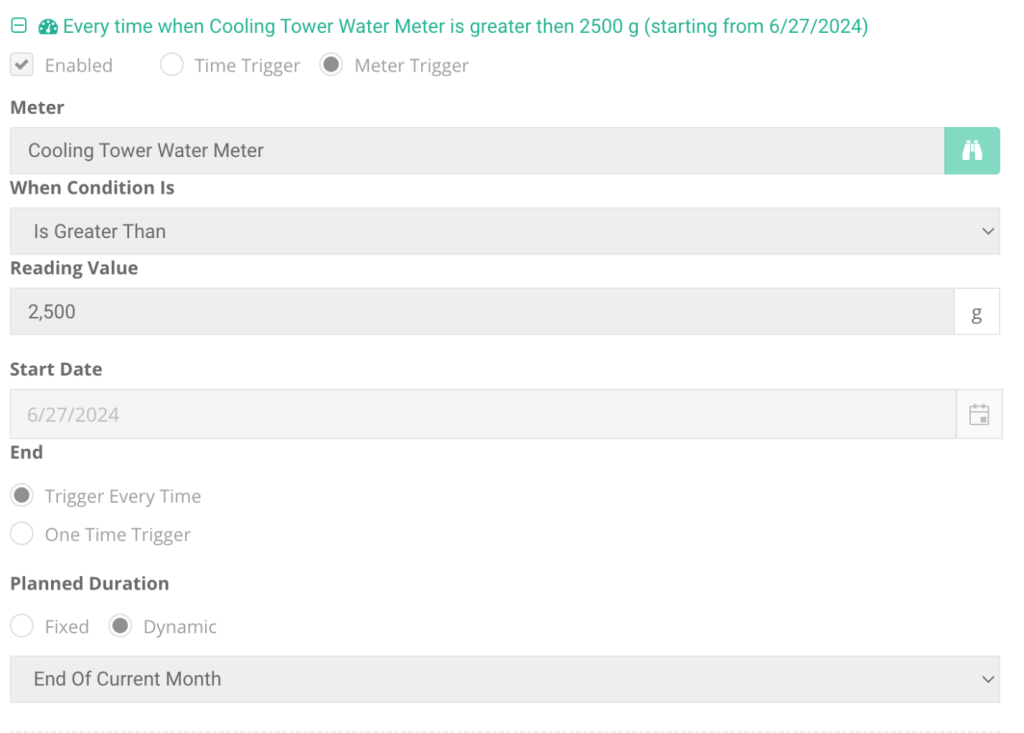
When IoT sensors are integrated with the CMMS, condition data such as temperature, vibration, or load is monitored in real-time.
This enables even more precise failure predictions and proactive maintenance scheduling, without the need for a full-scale PdM system from day one.
For teams with limited resources, this incremental approach provides an affordable and scalable path away from reactive maintenance.
Aging Infrastructure and Integration Complexity
About one-third of maintenance professionals identify aging equipment as a barrier to better maintenance.
On the one hand, older machines are more prone to failure and often require more frequent maintenance.
On the other hand, they typically lack the built-in connectivity required for IoT-enabled monitoring, making them difficult to include in modern PdM programs.
Legacy machines—such as hydraulic presses, gear-driven pumps, or older CNC systems—often don’t have standard ports or digital interfaces for sensor integration.
As a result, manufacturers must rely on external retrofitting, like mounting vibration sensors or temperature probes.
These installations can be technically demanding, with challenges such as:
- Lack of physical mounting space or accessibility
- Interference with existing control systems
- Potential downtime for installation and testing
- Inconsistent sensor data due to improper positioning or environmental noise
For example, retrofitting an older motor with a vibration sensor may require custom brackets and wiring through tight enclosures, followed by calibration and testing to ensure accurate readings.
In some cases, these retrofits introduce more complexity than value if not planned carefully.
Integration with existing industrial control systems, like PLCs or SCADA, is another hurdle.
Legacy systems may utilize outdated protocols or lack the necessary input/output (I/O) points, necessitating middleware or custom development.
Without a coordinated rollout, these upgrades can interrupt production and overwhelm IT or maintenance teams.
Cybersecurity Risks
With every additional IoT device comes an expanded attack surface, and manufacturing organizations face frequent and growing threats to connected assets.
According to Check Point research, 54% of companies experience attempted cyberattacks on IoT devices every week.
In manufacturing specifically, the average is 49 targeted attacks per organization per week.
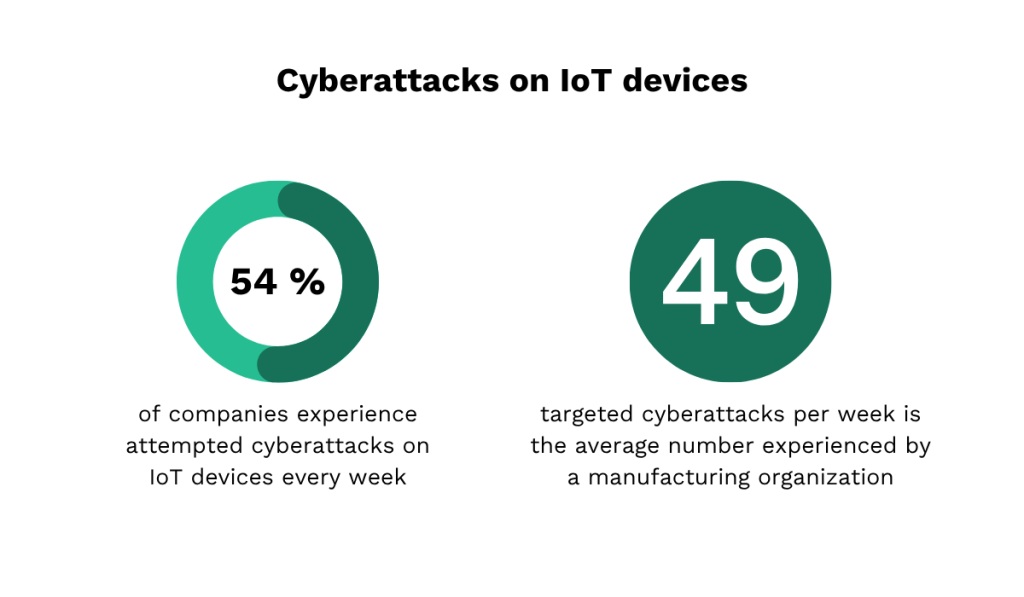
The financial stakes are high, too.
IBM’s 2024 report revealed that the average cost of a data breach in the manufacturing sector exceeds $5.5 million.
This includes damage to production, loss of intellectual property, and regulatory consequences.
Robust cybersecurity is, therefore, non-negotiable.
Manufacturers must adopt strong encryption protocols, secure authentication mechanisms, and continuous monitoring to protect their systems.
However, building such defenses requires both investment and internal expertise, which are often in short supply.
Data Reliability
Predictive maintenance relies on clean, consistent sensor data and stable connectivity.
Yet, in harsh industrial environments, sensors are often exposed to heat, vibration, dust, and moisture, all of which can degrade performance.
Inconsistent signals can result in false alarms or, worse, missed failure warnings.
As Karim Elbaz, Head of Growth at OCP MS, explains, installing a sensor on a critical asset essentially transfers the asset’s criticality to the sensor itself.
In other words, improper sensor placement, mishandling during maintenance, or undetected faults can undermine the system’s reliability.
To address this, OCP MS invested in both AI-driven sensor diagnostics and training programs for technicians, emphasizing that success depends as much on people and processes as on technology.
Similarly, Carlos E. Torres, CEO of predictive maintenance platform Power-MI, observes that sensor-related issues, such as signal noise, outliers, calibration failures, and connection errors, are common during system commissioning.
“In my experience, issues like noise, outliers, missing values and calibration error failures are typically addressed during the commissioning phase of sensors and systems.”
He adds that many teams are unaware that the monitoring system itself needs monitoring.
In some cases, maintenance staff unknowingly reposition or misconfigure sensors during routine work, compromising the entire predictive system.
These examples illustrate a broader challenge.
The reliability of IoT-enabled PdM is only as strong as the reliability of the underlying data infrastructure.
Ultimately, ensuring data integrity requires rigorous setup, ongoing oversight, and a culture of accountability.
Conclusion
IoT plays an indispensable role in predictive maintenance.
Without sensors, there is no real-time data. And without data, there is no predictive insight.
IoT devices enable continuous monitoring of asset conditions, early detection of anomalies, and prompt action before failures occur.
While implementation comes with challenges, the value is clear: fewer breakdowns, lower costs, and smarter maintenance decisions.
For manufacturers aiming to stay competitive, IoT-powered predictive maintenance is the next logical step.




